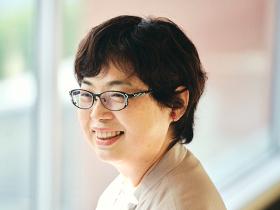How do advanced medical technologies such as assisted reproductive technology and noninvasive prenatal genetic testing change our way of life today?
Since the late 20th century, assisted reproductive technology (ART) has become commonplace worldwide. The number of children born in Japan as a result of in vitro fertilization is growing by the year. This has led in recent years to increasing debate around the applicability of medical insurance to infertility treatment, the use of noninvasive prenatal genetic testing, and the right of children born from eggs or sperm donated by a third party to learn about their origins (obtain information about the donor). Since she was a graduate student, Professor Azumi Tsuge has engaged in research into such medical technology and its relationship to life and society, while seeking out the views of those affected by it. Professor Tsuge often talks to the media, the medical community, and government about the results of her research. Here she talks about her desire to tell students about her motivation and the social significance of addressing ART and other topics relating to life and medical technology, in the hope of building a richer society accepting of diversity.


Azumi Tsuge
Vice President (Professor, Faculty of Sociology and Social Work)
After completing the Master’s program in Regulatory Biology at Saitama University’s Graduate School of Science, she completed a doctoral program at Ochanomizu University’s Graduate School of Humanities and Sciences, earning a Ph.D. Before joining Meiji Gakuin University’s Faculty of Sociology and Social Work as an associate professor in the Department of Sociology, she was a lecturer in the Faculty of General Education at the Health Sciences University of Hokkaido. Professor Tsuge previously served as Dean of the Faculty of Sociology and Social Work. Her books include Reproductive Technology as Culture: Narratives of Japanese gynecologists regarding infertility treatment (Shoraisha; awarded the 20th Yamakawa Kikue Prize), Considering Pregnancy: The politics of the body (NTT Publishing), and Reproductive Technology: What does infertility and regenerative medicine bring to society? (Misuzu Shobo).
-
Has medical technology really brought us happiness?
Developed in the late 20th century, assisted reproductive technology (ART) is a relatively new technology for treating infertility and enabling people to give birth to children as a result of in vitro fertilization and embryo transplantation. The first successful birth resulting from in vitro fertilization and embryo transplantation was reported in the UK in 1978. Japan’s first birth brought about by in vitro fertilization took place five years later.
Since then, ART has provided a helping hand to many people struggling with infertility worldwide. According to data published by the Japan Society of Obstetrics and Gynecology (JSOG) in October 2020, Japan recorded its highest-ever number of births due to in vitro fertilization in 2018, at 56,979 infants, accounting for around 1 in every 16 live births. Even before ART became available, many children were born as a result of artificial insemination by donor (AID). For couples longing for a child, such medical technology truly was one of the blessings of modern technology.

However, at the same time, ART brings with it a variety of social and cultural issues, such as the safety of the technology itself and bioethics. In many developed countries overseas, the technology is regulated and controlled by law to ensure its safety and guarantee ethical standards. In Japan, however, despite repeated deliberations by advisory bodies to the Ministry of Health, Labour and Welfare (and previously the Ministry of Health and Welfare) since the 1990s, no legislation has been created. Currently, although JSOG, as a professional organization for medical personnel, has introduced voluntary regulations, the lengthy debate among experts continues over various issues, such as the donation of sperm and eggs by third parties and the right of the children to learn about their origins.
Majoring in biology at university, I studied the basic knowledge on which ART is founded. I became interested in the effects on individual lives and on society and culture in general resulting from ART, as a technology for creating life via biological processes, and decided to undertake research in the fields of bioethics and medical anthropology. From there, I expanded my perspective further to encompass gender studies, approaching the topic from such angles as medical technology and gender, prenatal diagnosis and the rights of the resultant children, infertility treatment and women’s lives, and other forms of regenerative medicine and disease in the context of aging. Mainly through interviewing those affected by them, I have identified issues that advances in medical technology present in regard to our way of life and have considered how society should guide technology.Have our views on life failed to keep up with advances in medical technology?
In my interview-based surveys, I use a technique called qualitative data analysis, which is essential to research in the social sciences. Qualitative data analysis is a method of examining a research topic based on qualitative data regarding people’s words and behavior, which is hard to quantify directly. While I describe the surveys as interviews, they do not merely involve listening to people talk. By analyzing the content of what they say, including cultural and social factors, individual personality and mindset, and experiences, I investigate the major factors influencing those people’s overall life choices and what social issues lie within them. For example, I consider such questions as the extent to which people expect to benefit from medicine and technology in pregnancy and during childbirth, and the decision process people go through based on their own preferences when deciding whether or not to seek prenatal diagnosis.
Although ART began to progress rapidly in the 1980s, people’s attitudes and views on life do not change so quickly. Society is unable to break free of the stigma that views infertility as something shameful and physicians primarily regard infertility as something to be “cured.” However, is “not having children” really something of which to be ashamed or unhappy? We should start by questioning this anew. There was a view that if physicians worked with a handful of lawyers to establish regulations, they might be able to solve the many issues and problems relating to ART in Japan. A great deal was entrusted to the judgment of experts. However, the reality is that quite a few of those seeking ART suffer distress and come up against difficulties. Regulations based on the values of medical professionals alone are unlikely to result in judgments that demonstrate empathy toward those seeking ART. Moreover, pregnancy and childbirth are not issues for women alone. Male partners and husbands are also stakeholders, but at present, quite a few men regard these issues as something that does not concern them. This means women end up bearing the burden of the issue on their own.
Physicians and the government are now starting to become aware of such problems and frameworks for considering future advances in life science technology and social regulations are, very gradually, beginning to be formed. Our research plays a part in this and we will continue to offer proposals to the medical community and government, while engaging with the views of those affected, including minorities who have been overlooked to date.

It is in the society in which we live now that we find topics to study
In my seminars, I get students to choose topics based on their own experiences and interests. As students join my seminar group because of their interest in my classes and research, many of them unsurprisingly tend to choose topics relating to medical care and life science technology. I ask my third-year seminar students to give their first presentation on why they chose my seminar group and, in talking about their reasons, many of them link their personal or health experiences or those of their family members to the topics that we research.
Seminar research involves firstly deciding on your pre-hypothesis, reading relevant literature before undertaking interview-based surveys, and then discussing your findings with the rest of the seminar group and summarizing it all in a paper.
The graduation theses produced so far have encompassed a truly diverse array of research projects, including such topics as dying with dignity, developmental disorders, sexuality, and medical care and social inequality, in addition to reproductive technology and prenatal diagnosis. The seminar that left the biggest impression on me was the one on the subject of “What is aging?,” for which students interviewed residents in rural Japanese mountain communities. There was also the seminar for which students interviewed foreign nationals living in Tokyo to study medical care in Japan as seen by foreign nationals living in Japan. Both resulted in impressive reports. Many MG students are diligent and observant, with a talent for quickly getting to know people, so they gather really great narratives from their interviews. But as they still lack experience of society and of considering issues, I provide them with teaching and advice on analysis. Then we put our heads together to think about why the situations they uncover arise.
At the moment, the students in my class are discussing how humanity has dealt with infectious diseases throughout history. With the pandemic having had a major impact on student life, the study of infectious diseases includes many topics about which students should learn in order to gain the knowledge and ideas required for life, including approaches to medical care and society. As it is a social problem that they themselves face, which is evolving in real time, the students are highly interested and are engaging enthusiastically with my classes.

All the media coverage of COVID-19 provides a great deal of material for students to learn and think about issues such as gender, social inequality, and responses by the national government and local governments. Once, disease was taken for granted as an inevitable part of life. However, now that advances in medical technology have made it possible to prevent and treat disease, excessive expectations for and over-reliance on medical care can be seen in some areas. While medical care is important, we are learning that it has limits. Moreover, we have learned from history that people can take a negative view of those who have become sick and that infectious diseases can become a trigger for discrimination. Indeed, this is being experienced in the real world today. I believe that if society takes a negative view of those who are sick or disabled, it will become an unpleasant society in which to live. The key to tackling this is accepting diversity. Students will create the society of the future, so I want them to fully grasp that productivity alone is not a yardstick for measuring people’s worth and that the presence of disease and disability actually indicates the richness of human life in a society and culture.
